|
Location:
Nr Rio Magdelena,
Huila, Southern
Colombia. |
Grid Reference: 1�
52' 54" N, 76� 15' 47" W. |

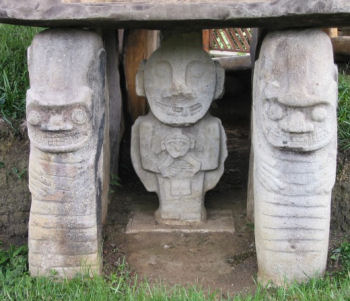 San
Agustin:
(Pre-Columbian Complex). San
Agustin:
(Pre-Columbian Complex).
The largest group of religious monuments
and megalithic sculptures in South America. Gods and mythical
animals are skilfully represented in styles ranging from
abstract to realist. These works of art display the creativity
and imagination of a northern Andean culture that flourished
from the 1st to the 8th century.
(2)
The San Agustin archaeological park in Colombia
includes a wide variety of stone sculptures, mostly carved between AD
100 and 1200. In the park are an amazing array of separate stone
sculptures, in the shapes of animals and warriors and human faces, some
mythical, some realistic. They are carved out of volcanic rock - some
are over 4 meters tall and weigh several tons. The site, excavated by K.
Th. Preuss during the 1940s, has been declared a World Heritage Site.
(Click
here for map)
Elevation 1,800m. Some 500 statues and
tombs are scattered in groups over an area on both sides of the Rio
Magdalena Gorge. The town of San Agustin is set in the middle of the
valley and is the best place from where to visit them.
The dozens of megalithic
sites nestled in the valleys of the Magdelena River combine to make this
site exceptional. The site are composed of mounded tombs, dolmen-like
structures and monolithic stone structures (linked to the 'Jaguar cult' by
some-see right).
The oldest
radiocarbon date from the area is 555 B.C.
(1)
The stonework includes
monolithic sarcophagi, some of which have lids in the form of
crocodiles, although none are found within 1000 miles of San
Agustin. (1)
A type of script has
been found at the site which remains un-translated.
(1)
The pre-Incan civilization that lived here
is shrouded in mystery, even their actual name is still unknown.
Archeologists have uncovered a
mere 10 percent of the statues and ruins, and it is theorized
that huge mayan-like pyramids and other structures remain buried throughout
the area. Other than the amazing statues, you can see burial chambers and
ritual edifices in the Parque Arqueologico and huge petroglyphs spread
throughout the valley.
There have been comparisons made with the Mayans of central America, and if
you follow the Rio Magdalena north from San Agustin you will see that it
begins on the Atlantic coast of Colombia very near the equally famous ruins
of the "Ciudad Perdida," a likely landing point if the Mayans took a boat
ride from the Yucatan Peninsula or crossed the Darien Gap into Colombia from
Panama. It should be noted that carbon dating between San Agustin and Ciudad
Perdida matches the same general time period of 555 BC to 1630 AD (from "San
Agustin" by Reichel Dolmatoff, 1972).
As far as culture and society, archaeologists have determined a few
things: The San Agustin people treated women as equals and superiors (they
did have female leaders), they had a grasp of advanced mathematics, they
attempted complex surgeries and they were obsessed with the idea of life
after death. People were ritualistically sacrificed, burned alive and
sometimes buried alive under the influence of hallucinogens.
The
Dolmen/Passage grave (below) is a mixture of both European and Olmec art (Jaguar
cult). 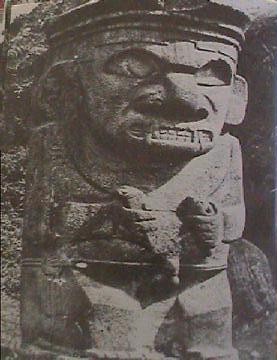

Most of these 'Dolmens' contain both stone
'guardians' (Portal stones), and a centrally located stone Jaguar-God
figure (Such as the one above, left), within the Dolmen.
(1)

Some of the structures share a similarity in design
with European megaliths.
|
Chronology:
'The San Agustin
region is located in the upper Magdalena River valley and is framed by
the Central and Eastern Cordilleras. As the site of the most striking
progression of monumental statuary, this part of Colombia has long
attracted the attention of social scientists. The ethnic history of
the region has been interpreted based on two different chronologies.
One of them, established by Luis Duque Gomez and Julio Cesar Cubillos,
postulates the theory of continuous development separated into an
Archaic period. from 3300 to 1000 B.C., a Formative period divided in
two phases: (Inferior, from 1000 to 300 B.C_ and superior. from 200
B.C. to 200 A.D.), a Regional Classical period from 300 A.D. and a
Recent period from 800 A.D. until the arrival of the Spaniards. The
other chronological theory was developed by Gerardo Reichel-Dolmatoff.
According to this archaeologist there might have been three principal
phases, marked by abrupt changes indicating the arrival of different
peoples. These stages are defined as: Horqueta, the beginnings are
undecipherable but it ends in 50 A.D.; Isnos, from 50 to 400 A.D., and
Sornbrerillos from 1400 to 1650 A.D. The two opinions coincide on some
significant points. Firstly, that the development of monumental
architecture, one of the most characteristic remains of the region.
corresponds to eras prior to the Spanish incursion. Duque and Cubillos
place the statuary's maximum level of development within the Regional
Classical period. from 300 to 800 A.D., while Reichel-Dolmatoff has
determined the highest development to have occurred between 50 to 400
A.D.. during the Isnos phase. Secondly, they concur that the builders
of the mounds and statuary belong to population phases associated with
an era during which the local economy was heavily dependent upon the
cultivation of maize'.
(Click here for full Article) |
Gold-working at San Agustin:
Gold-working
development follows along the following lines: In various parts of the
region, hammered gold tubular and round necklace beads, diadems, wires,
nose ornaments, gold rings with stone beads, H shaped diadems and gold
covered seashells have been discovered throughout the region in
association mound burials. These objects, which correspond to the
statuary development, reflect ties with Calima, southern Imabaya and
Tolima goldwork developments. On the other hand, the discovery of
smelted drops of gold and fragments of golden sun rays in addition to
the presence of alluvial gold in the regions's rivers - particularly
Manzanares and Sombrerillos - point to the local production of those
metallic objects.
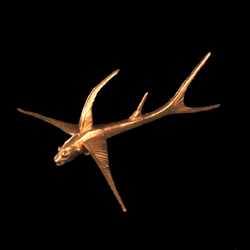
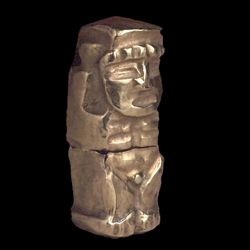
Gold items discovered at San Agustin.
The last phase of San Agustin gold-working is poorly documented.
However, the few existing references suggest the elaboration of turnbaga
nose rings. In other words, once again the large, spectacular hammered
gold pieces disappear, being replaced by the production of large
quantities of smaller objects. using the lost wax process.
(3)
Gallery of Images:
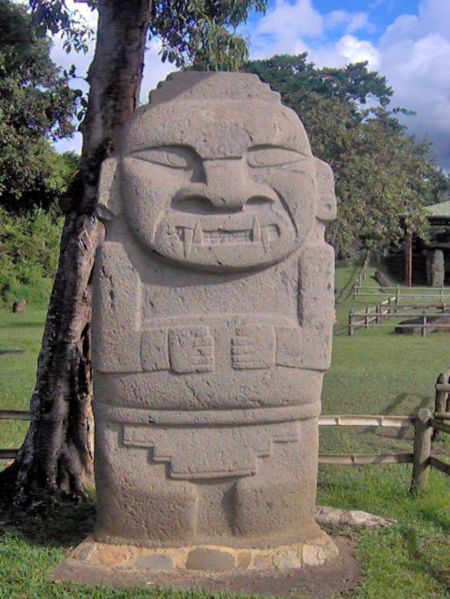

Jaguar god (left), and bird with snake (right).


Two of the 'Dolmen-shrines', common in the area.
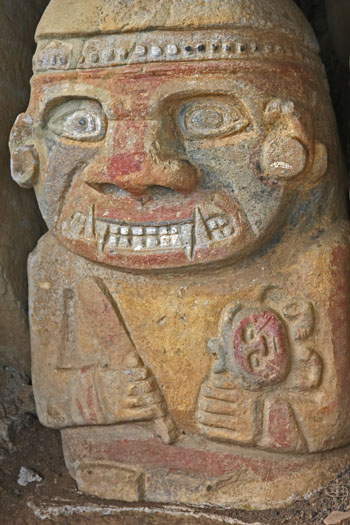
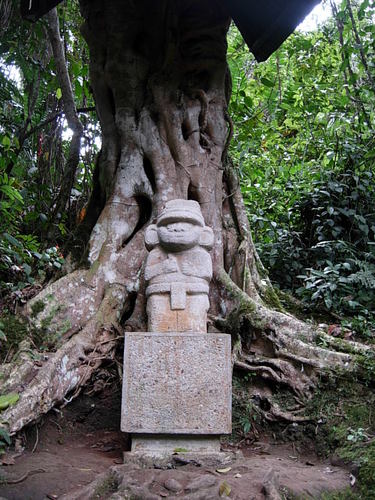
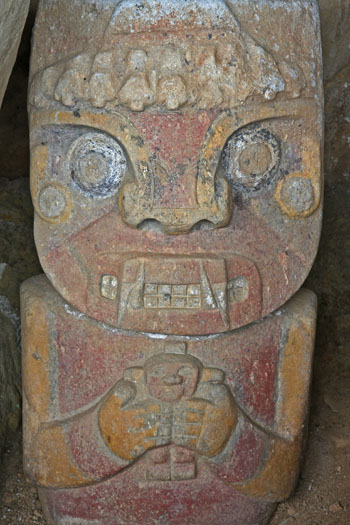
The area is littered with beautifully decorated stone statuettes.

Carved river beds were a common feature in Oriental and South American
architecture..
(Other
Pre-Columbian Sites) (Additional
Information on San Agustin at SacredSites.com)
|
 San
Agustin:
San
Agustin:










